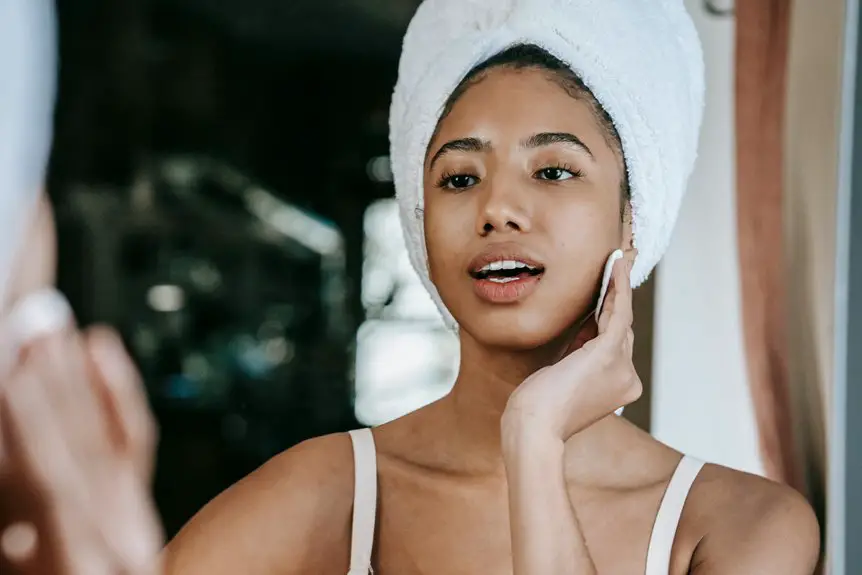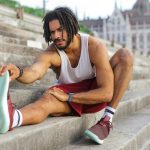Imagine you’re halfway through a long run, and your cotton shirt is soaked and heavy, clinging uncomfortably to your skin. You might think all workout clothes perform the same, but that’s far from true. Choosing moisture-wicking fabrics can make a significant difference in how you feel and perform, especially when sweat starts to build. Understanding why these materials outshine cotton could change the way you approach your exercise gear.
Table of Contents
Key Takeaways
- Moisture-wicking fabrics pull sweat away from skin, keeping you dry and comfortable during workouts unlike cotton, which retains moisture.
- These fabrics regulate body temperature effectively, preventing overheating and improving athletic performance and endurance.
- Moisture-wicking materials reduce skin irritation and chafing by promoting airflow and quick sweat evaporation, protecting skin health.
- They dry faster and resist wear, maintaining durability and shape longer than cotton for versatile, long-lasting use.
- Designed with hydrophobic fibers and breathable structures, moisture-wicking gear enhances comfort and is ideal for high-intensity and outdoor activities.
Enhanced Comfort During Workouts
Although both moisture-wicking fabrics and cotton have their benefits, moisture-wicking materials keep you more comfortable during workouts by quickly drawing sweat away from your skin.
When you wear breathable fabrics designed for exercise, you reduce the sticky, heavy feeling that often comes with cotton soaking up moisture. This helps regulate your body temperature and prevents chafing, so you can focus on your performance without constant discomfort.
Cotton tends to hold onto sweat, which lowers comfort levels and can make you feel cold and clammy once you stop moving. Choosing moisture-wicking clothing means you stay dry and cool, even during intense sessions.
Superior Moisture Management Capabilities
When you exercise, moisture-wicking fabrics pull sweat away from your skin using capillary action, keeping you dry.
They also speed up evaporation, so you stay cooler and more comfortable.
Cotton, on the other hand, tends to hold moisture, which can weigh you down during workouts.
Capillary Action Efficiency
Because moisture-wicking fabrics use capillary action to draw sweat away from your skin, they keep you drier and more comfortable during exercise. This process enhances moisture absorption by pulling sweat into tiny fibers that spread it out evenly.
You’ll notice:
- Sweat moves quickly from your skin to the fabric’s surface.
- Moisture disperses across a larger area, preventing saturation.
- Your skin stays dry, reducing irritation and chafing.
- The fabric maintains a lightweight feel even during intense workouts.
Unlike cotton, which traps moisture close to your skin, moisture-wicking materials excel in capillary action efficiency.
This superior moisture absorption keeps you feeling fresh and focused, helping you perform at your best without the discomfort of damp clothing.
Rapid Evaporation Benefits
While moisture-wicking fabrics pull sweat away from your skin efficiently, they also speed up evaporation to keep you cooler and drier.
This rapid evaporation speed means sweat doesn’t linger on your skin, reducing discomfort and the risk of chafing. Thanks to enhanced sweat transport, moisture moves from your body to the fabric’s surface quickly, where it evaporates faster than with cotton.
Cotton, on the other hand, absorbs sweat but traps it, slowing evaporation and leaving you feeling damp. By choosing moisture-wicking materials, you guarantee that sweat dries almost as fast as it appears, maintaining your comfort during intense workouts.
This superior moisture management capability helps regulate your body temperature effectively, so you can focus on your exercise without distraction or irritation.
Boosting Athletic Performance
You’ll perform better when your clothing helps regulate your body temperature and stays lightweight.
Moisture-wicking fabrics keep sweat off your skin, letting you stay focused and comfortable throughout your workout.
Choosing the right gear can make a real difference in how well you push yourself.
Temperature Regulation Benefits
Though both moisture-wicking fabrics and cotton absorb sweat, moisture-wicking materials actively pull moisture away from your skin, helping regulate your body temperature during exercise.
This sweat regulation prevents overheating and keeps you comfortable. Here’s how temperature control benefits your workout:
- Your skin stays drier, reducing chills from damp fabric.
- Sweat evaporates faster, cooling you down efficiently.
- Your core temperature remains stable, enhancing endurance.
- You avoid distractions from overheating or excessive sweating.
Lightweight Clothing Advantage
Maintaining a stable body temperature during exercise sets the stage for ideal performance, and choosing the right clothing plays a big part in that. When you opt for moisture-wicking fabrics, you benefit from a lightweight design and breathable materials that keep you agile and comfortable. Unlike cotton, which tends to hold moisture and add weight, moisture-wicking gear minimizes drag and lets your skin breathe freely.
| Feature | Moisture-Wicking Clothing |
|---|---|
| Weight | Lightweight design |
| Material | Breathable fabrics |
| Moisture Control | Efficient moisture removal |
| Comfort | Stays dry and light |
| Performance | Enhances movement |
This combination guarantees you move faster and feel less weighed down, boosting your athletic performance remarkably.
Enhanced Focus During Workouts
When your workout gear keeps you dry and comfortable, it’s easier to stay mentally sharp and fully engaged in your routine. Moisture-wicking fabrics help maintain mental clarity by preventing distractions caused by sweat-soaked cotton. This allows you to focus on mindful breathing and precise movements, boosting your performance.
Here’s how moisture-wicking clothing enhances focus during workouts:
- Keeps sweat away from your skin, reducing irritation and discomfort.
- Helps regulate body temperature, so you avoid overheating.
- Supports sustained energy levels by keeping you dry and cool.
- Promotes mindful breathing by eliminating distractions linked to damp clothing.
Choosing moisture-wicking gear means you stay present, confident, and fully connected to your athletic goals throughout every session.
Health Advantages of Moisture-Wicking Fabrics
Because moisture-wicking fabrics pull sweat away from your skin, they help keep you dry and comfortable during exercise.
These breathable textiles promote better airflow, reducing overheating and preventing the sticky, clammy feeling you often get with cotton. When sweat lingers on your skin, it can lead to irritation, rashes, or even fungal infections.
By efficiently moving moisture away, moisture-wicking fabrics support your skin health, minimizing these risks. You’ll notice fewer distractions caused by damp, heavy clothing, allowing you to focus more on your workout.
Plus, staying dry helps regulate your body temperature, reducing heat-related discomfort and fatigue.
Choosing moisture-wicking gear means you’re investing in both comfort and the long-term well-being of your skin during physical activity.
Durability and Multi-Use Flexibility
Keeping your skin dry and comfortable is just one part of what makes workout gear effective. When you consider durability comparison, moisture-wicking fabrics clearly outperform cotton. They resist wear and tear longer, maintaining their shape and function through countless washes.
Plus, their multi-use adaptability means you can wear them beyond workouts—whether running errands or lounging at home.
Here’s how moisture-wicking materials stand out:
- Retain strength and elasticity after heavy use
- Resist pilling and fading better than cotton
- Adapt to different activities without losing comfort
- Dry quickly, reducing downtime between uses
Choosing moisture-wicking fabric gives you gear that’s tough, versatile, and ready for whatever you throw at it—far beyond what cotton can offer.
Practical Benefits for Various Activities
Although both fabrics have their uses, moisture-wicking materials offer practical benefits that make them ideal for a variety of activities beyond just exercise.
When you’re in yoga sessions, moisture-wicking fabrics keep you dry and comfortable, preventing distractions caused by sweat. For outdoor sports, these materials quickly pull moisture away from your skin, helping regulate your body temperature and reducing chafing during intense movement.
Unlike cotton, which absorbs sweat and stays damp, moisture-wicking fabrics dry fast, meaning you won’t feel weighed down or cold after a workout or outdoor play.
Moisture-wicking fabrics dry quickly, keeping you light and comfortable unlike cotton that stays damp.
Whether you’re hiking, cycling, or practicing yoga, choosing moisture-wicking gear guarantees you stay comfortable and focused, letting you perform your best without worrying about sweat-soaked clothes slowing you down.
Technology Behind Moisture-Wicking Materials
Three key technologies make moisture-wicking materials stand out from traditional fabrics like cotton.
These fabric innovations focus on superior moisture control, keeping you dry and comfortable during workouts. You’ll notice how these materials pull sweat away from your skin, speeding evaporation.
Here’s how they work:
- Hydrophobic fibers repel water, directing sweat outward.
- Capillary action moves moisture through tiny channels in the fabric.
- Breathable mesh structures enhance airflow and cooling.
- Quick-dry finishes speed up evaporation for faster drying times.
Frequently Asked Questions
Can Moisture-Wicking Fabrics Cause Allergic Reactions?
Yes, moisture-wicking fabrics can cause allergy triggers for some people. If you have sensitive skin, you might experience skin reactions from certain materials or chemicals used in these fabrics. Always check product details to avoid issues.
How Do Moisture-Wicking Clothes Impact Environmental Sustainability?
You’ll find moisture-wicking clothes often use sustainable materials and eco-friendly practices, reducing environmental impact. Choosing these fabrics supports greener production methods, helping you stay active while caring for the planet.
Are Moisture-Wicking Fabrics Suitable for People With Sensitive Skin?
Imagine a gentle breeze against your skin—moisture-wicking fabrics, with their smart fabric composition, offer sensitive skin benefits by reducing irritation and dryness. You’ll feel cooler, drier, and more comfortable during any workout or daily activity.
What Are the Care Instructions for Moisture-Wicking Garments?
You should follow specific washing techniques like using cold water and gentle detergents to protect your moisture-wicking garments. Avoid fabric softeners, and always air dry them to maintain their performance. These care tips extend their lifespan.
Do Moisture-Wicking Fabrics Retain Colors After Multiple Washes?
Imagine colors dancing brightly after every wash—you’ll find moisture-wicking fabrics offer impressive color retention and fabric durability. They resist fading better than many materials, so your workout gear stays vibrant and strong through countless sessions.
- Natural Cotton Scrim: An Eco-Friendly Choice for Theatre and Apparel - June 26, 2025
- A Guide to Lighting Scrim Fabric for Film and Photography - June 26, 2025
- Composite Laid Scrims: The Future of Lightweight Reinforcement - June 26, 2025







